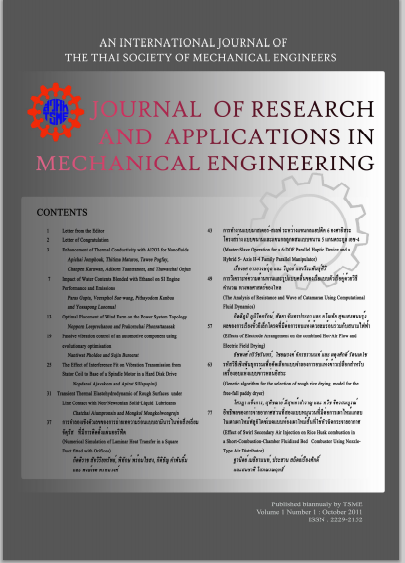Passive vibration control of an automotive component using evolutionary optimisation
Main Article Content
Abstract
In this paper, the use of multiobjective evolutionary optimisers for passive vibration suppression of an automotive component is demonstrated. The component is used to connect a car engine to some point of a car body between the front seats. Under such a circumstance, the structure is subject to several mechanical phenomena e.g. stress failure, fatigue, vibration resonance, and vibration transmissibility. The optimisation problem is posed to find structural shape and size such that maximising structural natural frequency and simultaneously minimising structural mass while constraints include stress failure and displacement. The multiobjective optimiser employed is the multiobjective version of Population-Based Incremental Learning (PBIL) with and without using a surrogate model. The optimum results obtained are illustrated and discussed. It is multiobjective evolutionary algorithm found that the proposed design scheme is effective and efficient for an automotive component design.
Article Details
This work is licensed under a Creative Commons Attribution-NonCommercial-ShareAlike 4.0 International License.
References
[2] Torstenfelt, B., Klarbring, A., 2007. Conceptual optimal design of modular car product families using simultaneous size. shape and topology optimization, Finite Elements in Analysis and Design, Vol. 43, pp. 1050-1061.
[3] Bureerat, S., Sriworamas, K., 2007. Population-Based Incremental Learning for Multiobjective Optimisation, Advance in Soft Computing, Vol. 9, pp. 223-231.
[4] Kanyakam, S., Bureerat, S., 2007. Passive Vibration Suppression of a Walking Heat and Mass Tractor Handlebar Structure Using Multiobjective PBIL. In: Proceedings of the 2007
IEEE Congress on Evolutionary Computation, Singapore.
[5] Kanyakam, S., Srisomporn, S., Bureerat, S., 2009. Optimal Geometrical Design of Multiple Heights Pin-Fin Heat Sink Using MOPBIL. In: Proceedings of the 23rd Conference of the
Mechanical Engineering Network of Thailand, Chiang Mai, Thailand.
[6] S., Srisomporn, S., Bureerat, 2008. Geometrical Design of Plate-Fin Heat Sinks Using Hybridization of MOEA and RSM, IEEE TRANSACTIONS ON COMPONENTS AND
PACKAGING TECHNOLOGIES, Vol. 31, pp. 351-360.
[7] Liao, X., Li, Q., Yang, X., Zhang, W., Li, W., (2008). Multiobjective optimization for crash safety design of vehicles using stepwise regression model. Struct Multidisc Optim, Vol. 35,
pp. 561–569.
[8] Lophaven, SN., Neilson, HB., Sondergaard, J., DACE a MATLAB Kriging Toolbox. Technical report IMM-TR-2002-12, Technical University of Denmark.
[9] Zhou, Z., Ong, YS., Lim, MH., 2007. Memetic algorithm using multi-surrogates for computationally expensive optimization problems. Soft Computing, Vol. 11, pp. 957-971.
[10] Farina, M., Amato, P., 2005. Linked interpolationoptimization strategies for multicriteria optimization problems. Soft computing, Vol. 9, pp. 54-65.
[11] Bureerat, S., Srisomporn, S., 2010. Optimum plate-fin heat sinks by using a multi-objective evolutionary algorithm. Engineering Optimization, Vol. 42, pp. 305-343.



